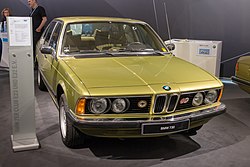| BMW 7 Series (E23) | |
|---|---|
 | |
| Overview | |
| Manufacturer | BMW |
| Production | May 1977 – June 1986 [1] 285,029 built [2] |
| Assembly |
|
| Designer | Paul Bracq, Manfred Rennen |
| Body and chassis | |
| Class | Full-size luxury car (F) |
| Body style | 4-door sedan/saloon |
| Layout | FR layout |
| Powertrain | |
| Engine | |
| Transmission | |
| Dimensions | |
| Wheelbase | 2,795 mm (110.0 in) [4] |
| Length |
|
| Width | 1,800 mm (70.9 in) [4] |
| Height | 1,430 mm (56.3 in) [4] |
| Curb weight | 1,470–1,629 kg (3,241–3,591 lb) |
| Chronology | |
| Predecessor | BMW E3 |
| Successor | BMW 7 Series (E32) |




The BMW E23 is the first generation of the BMW 7 Series luxury cars and was produced from 1977 until 1986. It was built in a 4-door sedan body style with 6-cylinder engines, to replace the BMW 'New Six' (E3) sedans. From 1983 until 1986, a turbocharged 6-cylinder engine was available.
Contents
- Development and production
- Engines
- Transmissions
- Equipment
- Yearly changes
- 1983 facelift
- 1984
- Special models
- 725i
- Turbocharged 745i
- South African 745i
- United States and Japanese market models
- References
- Footnotes
In 1986, the E23 was replaced by the E32 7 Series, however, the E23 models (called L7) remained on sale in the United States until 1987.
The E23 introduced many electronic features for the first time in a BMW, including an on-board computer, service interval indicator, a "check control panel" (warning lights to indicate system faults to the driver), a dictaphone and complex climate control systems. [5] [6] It was also the first BMW to offer an anti-lock braking system (ABS), [7] [8] a driver's airbag (optional, starting in April 1985 [9] [10] ) and a new design of front suspension. [11]



